10 Real Estate Software Development Companies in 2025
- February 03
- 9 min

IoT integration for large-scale property portfolios involves using interconnected devices and real-time data to enhance operational efficiency, tenant satisfaction, and cost management. By automating systems like HVAC, lighting, and security, property managers can streamline processes and address inefficiencies. This technology transforms properties into smart, data-driven ecosystems, ensuring long-term success and competitiveness.
Managing extensive property portfolios comes with a unique set of challenges. From ensuring operational efficiency across numerous sites to maintaining tenant satisfaction, property managers face a balancing act that is both complex and resource-intensive. The larger the portfolio, the more difficult it becomes to standardize processes, optimize costs, and meet evolving tenant expectations. Operational inefficiencies often lead to high energy consumption, unplanned maintenance, and fragmented workflows, while rising utility expenses and outdated technology strain budgets.
This article will explore the benefits of IoT integration, practical applications and strategies to implement IoT technologies effectively in large-scale property portfolios. Whether you’re navigating operational inefficiencies or aiming to boost tenant satisfaction, IoT offers tools to modernize how properties are managed. Read on to learn how this technology can turn your property portfolio into a streamlined, data-driven ecosystem.
Internet of Things (IoT), at its core, is a network of interconnected devices that collect, share, and analyze data to enhance operational capabilities. These systems rely on sensors, software, and connectivity to provide insights and enable automation. While its applications span numerous industries, IoT’s potential in property management is particularly groundbreaking, especially for large-scale property portfolios.
Integrating IoT into large-scale property management is transforming the way modern buildings are operated and maintained. By leveraging smart technology, property managers can enhance efficiency, reduce costs, and deliver a better experience for tenants and stakeholders.
|
Benefit |
Description |
Examples/Benefits |
|
Automating Routine Tasks |
Use IoT to automate functions like lighting, HVAC, and energy management, reducing manual work and errors |
Smart lighting adjusts for occupancy; HVAC maintains preset temperatures automatically; energy use is optimized |
|
Real-Time Monitoring and Corrective Actions |
IoT sensors continuously track system performance and flag inefficiencies for fast resolution |
Quickly detect high energy usage, faulty equipment, or leaks; minimize disruptions and enable fast responsive action |
|
Predictive Maintenance Minimizes Downtime |
Sensors monitor equipment health to anticipate failures before they happen |
Automated alerts for abnormal operation; schedule repairs only when needed; reduce unexpected breakdowns and costs |
|
Cost Savings Through Operational Efficiency |
IoT-driven automation and monitoring cut labor and utility costs, and reduce expensive emergency repairs |
Lower staffing costs, energy savings, fewer emergency calls, improved tenant retention and stronger cash flow |
Smarter Properties, Stronger Results
IoT provides a framework for ongoing process improvement and management success by boosting portfolio competitiveness, streamlining management, and driving long-term financial and operational benefits.
IoT (Internet of Things) technology has opened up a world of possibilities for property managers, helping them streamline operations, enhance tenant experiences, and improve overall portfolio performance. By leveraging interconnected devices and real-time data insights, property managers can address inefficiencies, strengthen security, and adopt sustainable practices. Below, we explore key IoT applications that are transforming large-scale property portfolios, like intelligent systems for smart building operations, advanced security, predictive maintenance, efficient space utilization, and sustainability.
Smart building systems equipped with IoT are revolutionizing how properties control HVAC, lighting, and energy management. These systems not only enhance operational efficiency but also contribute to tenant comfort and satisfaction.
IoT-connected HVAC systems provide automated temperature control by analyzing factors like indoor air quality, external weather conditions, and building occupancy levels. These systems can adjust heating and cooling dynamically, ensuring consistent comfort without wasting energy. For example, common areas or lightly used spaces can receive less heating or cooling while prioritizing comfort in high-traffic zones.
IoT-enabled lighting systems use motion and occupancy sensors to control illumination based on need. Lights can automatically switch off when a room is empty or adjust brightness throughout the day to align with natural sunlight. This helps reduce electricity usage while maintaining an optimal environment for tenants.
IoT platforms streamline energy consumption by collecting data from across a property’s systems. Energy usage patterns are tracked in real time, allowing managers to identify inefficiencies, implement targeted reduction strategies, and ensure optimal resource use. For instance, IoT can identify unusually high energy consumption in a specific building, prompting timely corrective actions like equipment inspection.
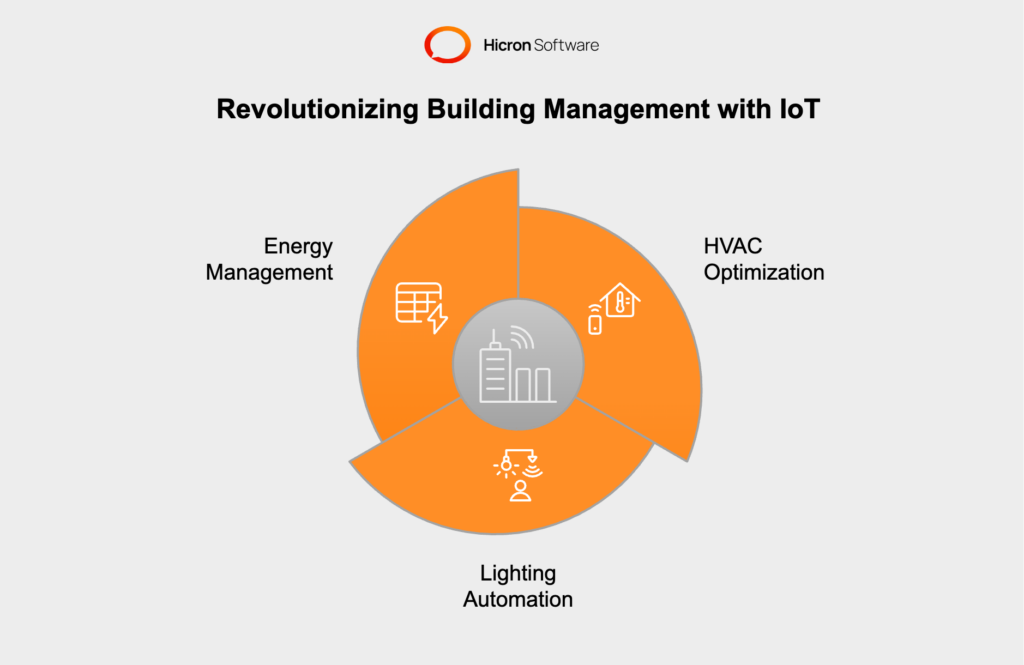
By automating these essential systems, property managers save time, reduce costs, and provide tenants with an enhanced living or working environment.
Maintaining a secure property portfolio is one of the most critical responsibilities for property managers. IoT technologies greatly enhance security by introducing intelligent surveillance, access control, and visitor management solutions.
IoT-connected cameras and sensors provide 24/7 monitoring of properties, transmitting real-time video feeds and alerts to central systems or mobile devices. These systems use features such as motion detection, facial recognition, and AI-based analytics to identify potential threats and help security teams respond immediately.
IoT-enabled smart locks give property managers more control over building access. Traditional keys are replaced with digital credentials, allowing tenants to unlock doors via smartphones or keycards. Managers can monitor access logs, grant temporary entry to service personnel, and revoke access in the event of a security breach, all in real time.
IoT technologies streamline visitor authentication and tracking processes. For example, guests can receive unique access credentials upon inputting their details into an IoT-based visitor management system, reducing delays and ensuring better oversight of who enters the premises.
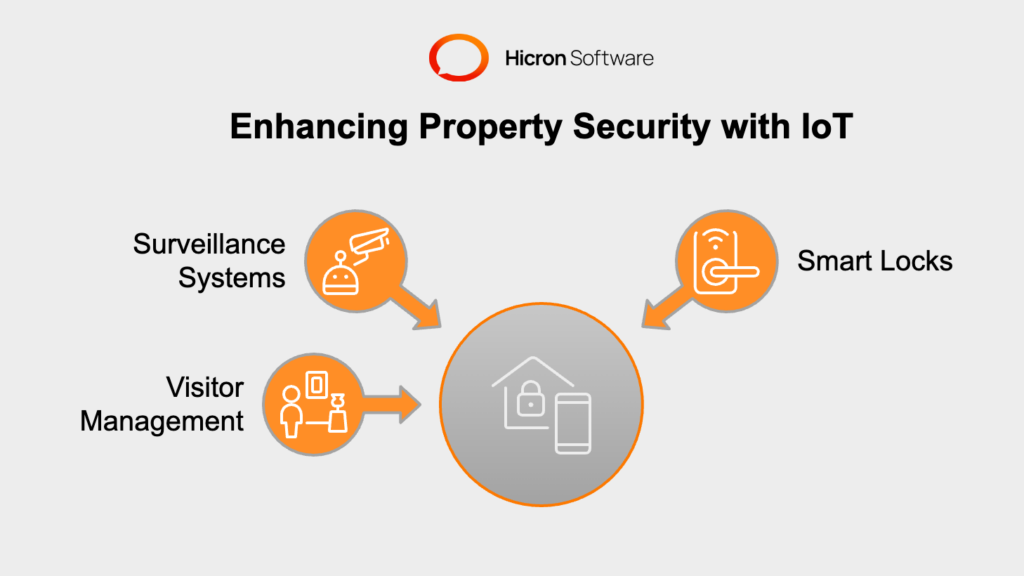
By integrating IoT into security systems, property managers can deliver a safer and more convenient experience for tenants and visitors while improving overall portfolio protection.
Traditional maintenance approaches often result in unnecessary downtime or more severe equipment failures due to reactive strategies. IoT introduces predictive maintenance, which relies on data from connected sensors to anticipate problems before they arise.
IoT sensors placed in critical systems, such as elevators, HVAC units, or boilers, continuously collect performance data. These sensors identify anomalies such as excessive vibrations, temperature irregularities, or wear and tear: indicators that suggest potential failures.
When an issue is detected, IoT systems automatically notify property managers, vendors, or maintenance teams, enabling quick action. For example, if a pump in an HVAC system is operating inefficiently, an alert ensures it can be serviced before it fails completely. This minimizes disruptions for tenants and prevents costly emergency repairs.
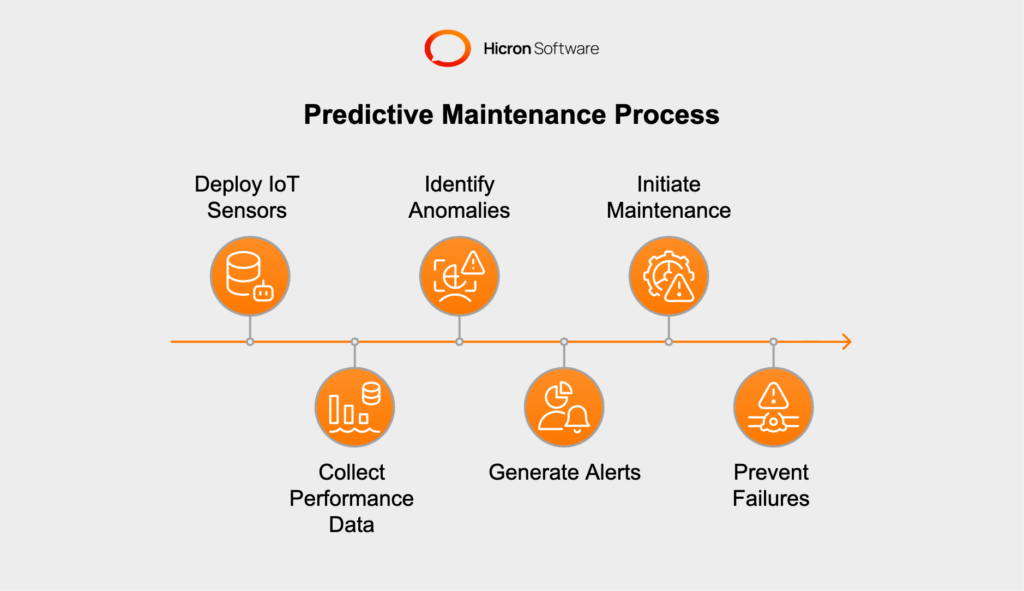
Predictive maintenance extends the life of assets and reduces unplanned downtime, ensuring properties are always in top condition.
Efficient space management is key to improving tenant satisfaction and maximizing operational output. IoT brings precision to this area through occupancy sensors and usage analytics.
These sensors track how spaces are being used in real time, highlighting areas that are overcrowded, underutilized, or mismanaged. Data collected from these sensors enables better space allocation, such as opening additional conference rooms when existing ones are full.
IoT systems generate visual reports that reveal patterns in how tenants interact with the property. For instance, analytics might show that a common area is frequently empty during working hours, suggesting its purpose could be adjusted. Similarly, co-working spaces could use IoT to allocate desks more efficiently based on actual demand.
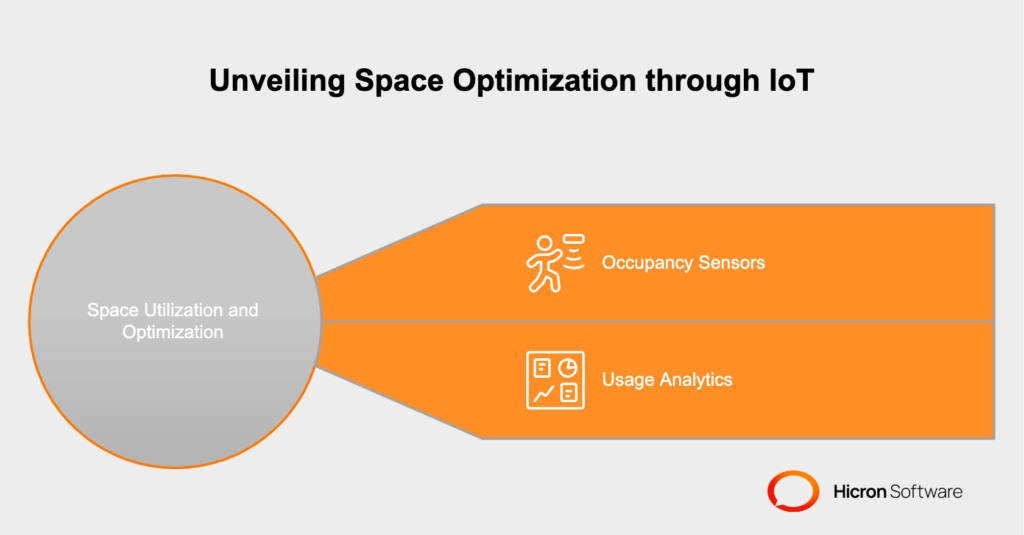
By understanding how every square foot of space is being used, property managers can improve tenant experiences and make data-driven decisions about renovations, leasing strategies, or amenity arrangements.
Sustainability becomes a key priority that both tenants and regulators expect. IoT provides valuable tools to help portfolios minimize environmental impact while keeping costs in check.
IoT water meters track consumption in real time, identifying leaks or inefficiencies as they happen. This not only prevents unnecessary waste but also lowers utility costs—a win-win for both the environment and the bottom line.
IoT supports renewable energy systems, such as solar panels, by providing data on energy generation, storage, and usage patterns. These insights allow properties to optimize energy consumption and rely less on traditional power grids, contributing to greener operations.
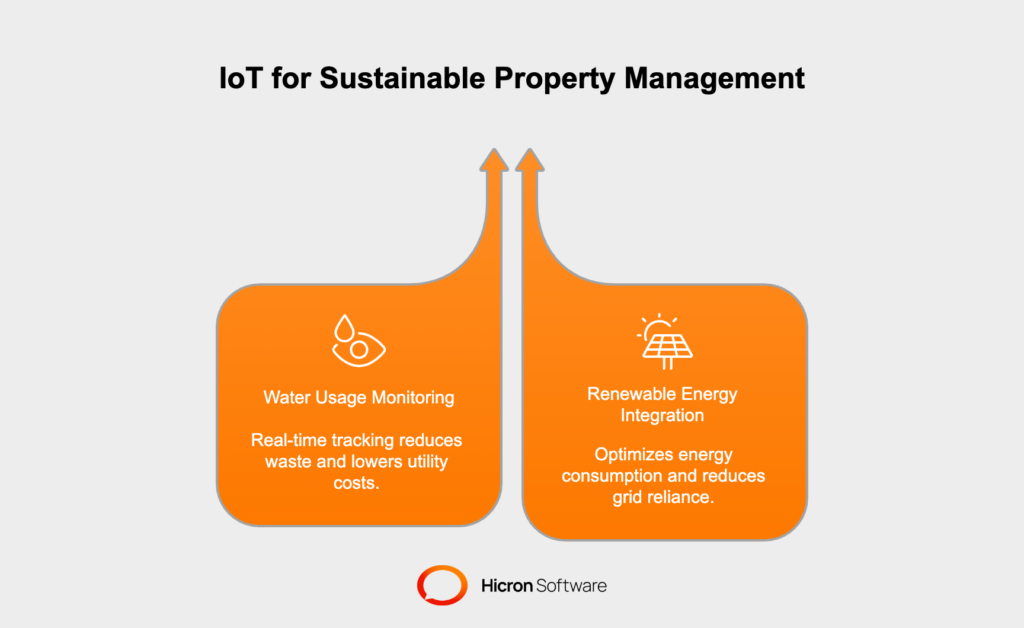
With IoT driving sustainability efforts, property managers can meet environmental goals, adhere to regulations, and build goodwill with eco-conscious tenants.
IoT applications reshape how large-scale property portfolios are managed. With intelligent systems for building operations, enhanced security measures, predictive maintenance, optimized space utilization, and sustainability, IoT proves essential for any modern property manager seeking operational excellence. By integrating these technologies, property managers can deliver greater tenant satisfaction, reduce costs, and achieve long-term success.
Integrating IoT into property portfolios requires a structured approach. The process involves careful planning, technology selection, and staged execution to ensure the adoption of systems that deliver maximum value. Here are the key implementation strategies to guide property managers through this transformation.
|
Implementation Strategy |
Key Points |
|
Assessment and Planning |
|
|
Technology Selection |
|
|
Integration with Existing Systems |
|
|
Pilot Programs |
|
|
Full-Scale Deployment |
|
Before introducing IoT solutions, a thorough assessment of the current infrastructure is essential. This phase involves evaluating the existing systems to determine their readiness for IoT upgrades and identifying any gaps that could hinder implementation. Key aspects to focus on include
Planning should include setting clear goals and Key Performance Indicators (KPIs) to measure the success of IoT integration. Goals might include
KPIs should align with these goals and could include metrics like
By defining objectives early, property managers can create a roadmap for implementation that is both targeted and measurable.
Choosing the right IoT platforms and devices is critical to establishing a cohesive and scalable system. Property managers should prioritize solutions that integrate with existing infrastructure while ensuring room for future growth. Scalability is particularly important for large-scale portfolios, as adding more devices or expanding functionality shouldn’t involve disruptive overhauls.
Interoperability is another key factor. IoT platforms must be able to communicate with existing property management software and third-party systems. Opting for devices compliant with open standards reduces the risk of vendor lock-in and facilitates adaptability as new technologies emerge. Selecting reliable vendors with robust support services ensures smooth implementation and ongoing maintenance.
For IoT systems to deliver their full potential, they must work in harmony with the portfolio’s existing technologies. Integration involves connecting IoT devices to property management software to centralize functionalities like
Ensuring smooth data flow between systems is critical. IoT platforms should consolidate data into an intuitive dashboard, enabling property managers to make informed decisions without sifting through disjointed reports.
For example, integrating HVAC sensors with energy management software allows managers to optimize heating and cooling in real time, reducing costs and improving tenant comfort.
Launching IoT solutions across an entire portfolio at once can be risky and overwhelming. Instead, pilot programs offer an effective way to test solutions on a smaller scale before full implementation. By selecting one or two properties, or even specific facilities to serve as testbeds, property managers can observe how systems perform in real-world conditions.
During the pilot phase, data collected can highlight
Gathering feedback from on-site staff and tenants further refines the setup. This iterative approach minimizes errors, fine-tunes technology configurations, and ensures that solutions are well-suited to broader deployment.
Once pilot programs have proven successful, property managers can proceed to full-scale deployment. This phase involves rolling out IoT technologies across the entire portfolio, a process that must be managed meticulously to avoid disruptions. A phased approach may be necessary for large portfolios, prioritizing high-traffic or high-cost areas first.
Equally important is the training of staff and stakeholders. Employees responsible for managing IoT systems need comprehensive training to understand how to operate and troubleshoot the technology. Building awareness among tenants about the benefits of IoT, such as enhanced comfort and security, ensures smoother adoption and higher satisfaction levels.
Integrating IoT into property portfolios comes with undeniable benefits, from improving operational efficiency to enhancing tenant experiences. However, adopting any new technology is not without its hurdles. Property managers must anticipate and address a range of challenges to ensure a successful IoT implementation. Below, we explore the key considerations for IoT integration, focusing on data security, costs, scalability, maintenance, and stakeholder buy-in.
|
Challenge/Consideration |
Description |
Key Points/Solutions |
|
Data Security and Privacy |
IoT systems handle large volumes of sensitive tenant and property data, increasing exposure to cyber threats and regulations. |
|
|
Cost of Implementation |
Initial expenses for devices, infrastructure, and integration can be high, with ongoing software and maintenance costs. |
|
|
Scalability and Interoperability |
Systems must grow with expanding portfolios and integrate with various devices/vendors. |
|
|
Maintenance and Upgrades |
IoT devices require periodic maintenance, updates, and eventual replacement as technology evolves. |
|
|
Stakeholder Buy-In |
Success relies on support from owners, staff, and tenants who must understand and effectively use IoT systems. |
|
While the challenges associated with IoT integration are complex, they are surmountable with careful planning and execution. By addressing data security, managing costs, ensuring scalability, planning for maintenance, and educating stakeholders, property managers can build robust IoT systems that enhance operations and deliver long-term value. Preparation and proactive management are the keys to unlocking the full potential of IoT in property portfolios.
Integrating IoT (Internet of Things) into property portfolios offers a wealth of benefits, from operational efficiencies to improved tenant experiences. However, achieving successful integration across large portfolios requires organization and strategy. A clear, well-defined roadmap ensures that the deployment process is efficient, scalable, and aligned with business goals. Below, we outline the step-by-step process for building an IoT integration roadmap for property portfolios.
|
Step |
Description |
Key Actions/Considerations |
|
Setting Objectives & KPIs |
Define goals and success metrics for IoT integration. |
Set specific objectives (e.g., energy reduction, tenant satisfaction) and determine relevant KPIs to track progress. |
|
Assessment of Infrastructure & Readiness |
Evaluate existing systems, technology, and network capabilities. |
Audit current assets; identify gaps in hardware, software, and network strength; outline upgrade requirements. |
|
Prioritization of Sites/Systems |
Select properties or systems best suited for initial rollout. |
Focus on areas with greatest need or opportunity for ROI; prioritize by inefficiencies, costs, or tenant challenges. |
|
Phased Rollout Planning |
Develop a step-by-step implementation plan to minimize risk and disruption. |
Organize deployment in phases, set milestones (e.g., start with HVAC/lighting in key properties before portfolio-wide roll). |
|
Resource Allocation |
Assign financial, technical, and human resources to support integration. |
Allocate sufficient budget, select technology and vendors, define team roles, plan for training and support. |
|
Feedback Loop & Strategy Refinement |
Monitor, measure, and adjust integration efforts as they progress. |
Use dashboards for real-time tracking, collect feedback from staff/tenants, and refine strategy based on insights. |
The first step in any roadmap is defining the ultimate objectives of IoT integration. Property managers must ask, “What do we want to achieve with IoT?” Goals could include:
Objectives should be specific, measurable, and aligned with the overall vision for the property portfolio.
Key Performance Indicators (KPIs) are essential for measuring progress. For example, if the goal is to cut energy usage, a KPI might track the percentage reduction in utility bills portfolio-wide. If predictive maintenance is the aim, KPIs might include a decrease in equipment downtime or a reduction in repair costs. These metrics will guide decision-making and enable teams to evaluate the success of their efforts.
Before introducing IoT technologies, conducting a thorough audit of the portfolio’s current infrastructure is essential. Assess which systems are already in place, such as HVAC, lighting controls, or security systems, and determine their compatibility with IoT devices. Identify areas that lack automation or connectivity and may require upgrades to support new technologies.
Infrastructure readiness also includes evaluating network capabilities. IoT devices rely heavily on strong, reliable connectivity, so examining internet bandwidth, wireless access points, and network security is critical. Property managers should create a detailed report highlighting potential gaps, such as outdated hardware or insufficient bandwidth, and outline the steps required to address them.
This assessment sets the foundation for a tailored IoT strategy, ensuring the chosen solutions align with the portfolio’s needs and existing systems.
Large property portfolios often make it impractical to deploy IoT across all sites simultaneously. Instead, prioritization helps focus resources where the impact will be highest. Begin by identifying properties or systems that would benefit most from IoT integration. Factors such as
can help pinpoint high-priority candidates for early adoption.
For instance, properties with outdated lighting or HVAC systems can serve as ideal starting points for IoT upgrades, as these improvements frequently provide immediate returns on investment. Similarly, properties with security challenges can prioritize IoT-enabled surveillance systems or smart locks. By targeting key areas first, property managers can maximize value while building confidence in the integration process.
Attempting to implement IoT solutions portfolio-wide in one step can be overwhelming and risky, especially if unforeseen challenges arise. A phased rollout plan offers a more controlled approach, focusing first on a small number of properties or systems to test the effectiveness of the technology in real-world scenarios.
Phased rollouts should include clear timelines and milestones. For example:
By breaking the process into manageable stages, property managers can identify and resolve challenges early, ensuring the broader rollout proceeds smoothly.
IoT integration requires adequate resources across multiple domains, including finances, technology, and personnel.
No roadmap is complete without a mechanism for monitoring progress and gathering feedback. IoT integration is a dynamic process, and adjustments may be necessary as the project evolves. Establishing a feedback loop ensures that property managers can evaluate performance at each phase and refine their approach as needed.
Digital dashboards are invaluable for tracking metrics like energy usage, equipment performance, and tenant satisfaction in real time. These insights can highlight areas requiring further optimization or additional resources. Simultaneously, gathering qualitative feedback from staff, tenants, and maintenance teams can uncover operational pain points and generate ideas for improvement.
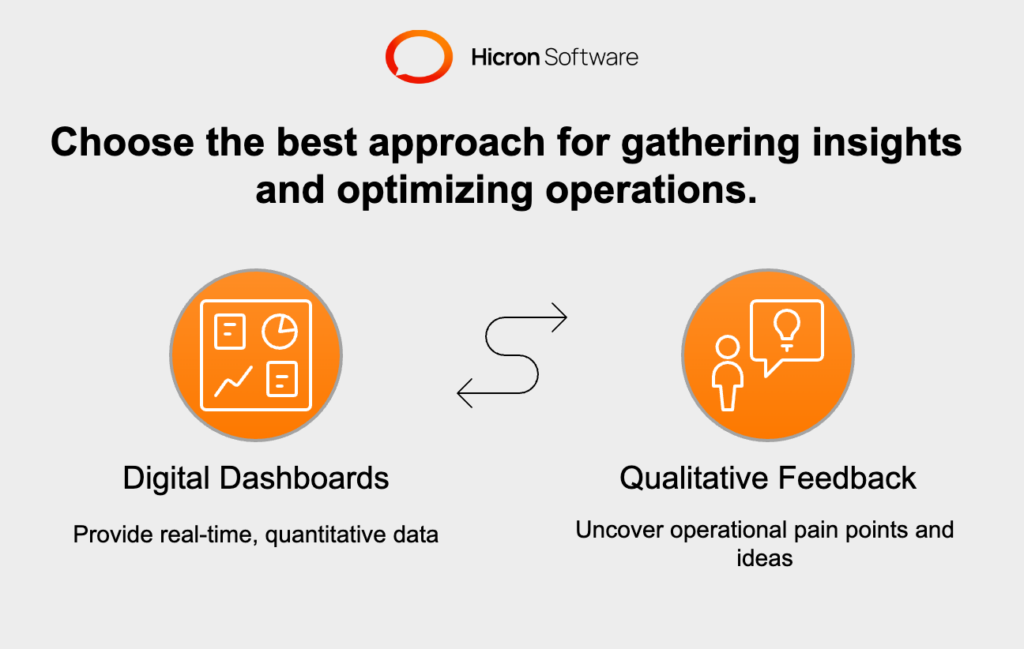
Regularly reviewing this data and using it to make informed decisions ensures that the IoT integration continues to deliver tangible results while adapting to unforeseen changes or challenges.
Building an IoT roadmap is the backbone of a successful integration strategy. By setting clear objectives, conducting a robust assessment, and managing a phased rollout with adequate resources, property managers can overcome the complexities of IoT adoption. A well-structured roadmap minimizes risks, maximizes ROI, and ensures that IoT technologies fulfil their potential to transform property portfolios into highly efficient, tenant-friendly assets.
IoT (Internet of Things) offers transformational benefits for property portfolios. However, the real power of IoT lies in its ability to adapt to the unique needs of each business. Standard solutions might not address every requirement, especially in diverse property portfolios that include both residential and commercial properties. By customizing IoT systems, businesses can unlock tailored functionalities that perfectly align with their goals and operations. Below is a detailed exploration of how IoT solutions can be customized to meet specific business needs.
One of the key ways IoT can be customized is through personalized dashboards that cater to the distinct roles of various users. Each stakeholder interacting with the system (whether property managers, maintenance teams, or tenants) has unique needs and expectations. A “one-size-fits-all” interface might lead to inefficiencies or underutilization of the solution.
IoT dashboards for property managers should focus on providing high-level insights. These might include metrics such as
Managers may also require tools for generating reports or setting Key Performance Indicators (KPIs) to assess overall system functionality.
Maintenance professionals benefit from dashboards that offer
For example, a maintenance dashboard could highlight an early warning from a smart HVAC system, enabling the team to address the issue before tenants are affected. This level of specificity ensures smooth operations and boosts cost efficiency.
Customized tenant-facing dashboards can enhance user experience and engagement. Features such as
Empower tenants to interact with their environment in meaningful ways. Apps or portals that integrate with IoT systems can elevate tenant satisfaction and improve retention rates.
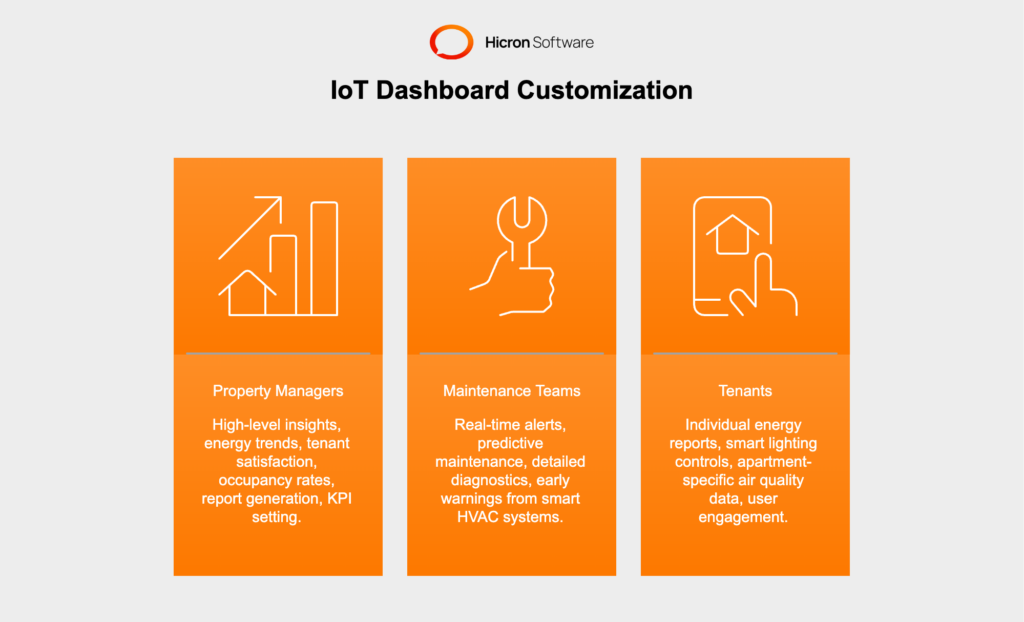
Another vital aspect of IoT customization is its ability to integrate with specialized, business-critical software systems. A fully connected ecosystem enables property managers to use IoT data effectively without juggling multiple applications. Here’s how such integration could work:
By combining IoT sensors with advanced EMS platforms, property managers gain access to precise energy consumption patterns for each property or unit. For example, IoT-enabled meters can feed real-time usage data into an EMS, enabling fine-tuned control of resources and reducing operational costs. Pairing these systems with AI-powered analytics can even recommend adjustments to optimize energy usage automatically.
Many modern properties offer tenant apps that allow residents to pay rent, submit maintenance requests, or access community amenities. Custom IoT integrations can link these apps with smart home features. For instance, tenants might be able to use the same app to adjust a smart thermostat, unlock doors, or monitor package deliveries via smart cameras.
IoT technologies like smart locks, surveillance systems, and visitor management platforms can integrate with access control software to provide an end-to-end solution for building security. This setup is particularly relevant in commercial properties, where tenants demand secure yet flexible entry solutions for employees, contractors, and guests. Custom configurations can align these features with business-specific protocols, such as time-based access for part-time staff.
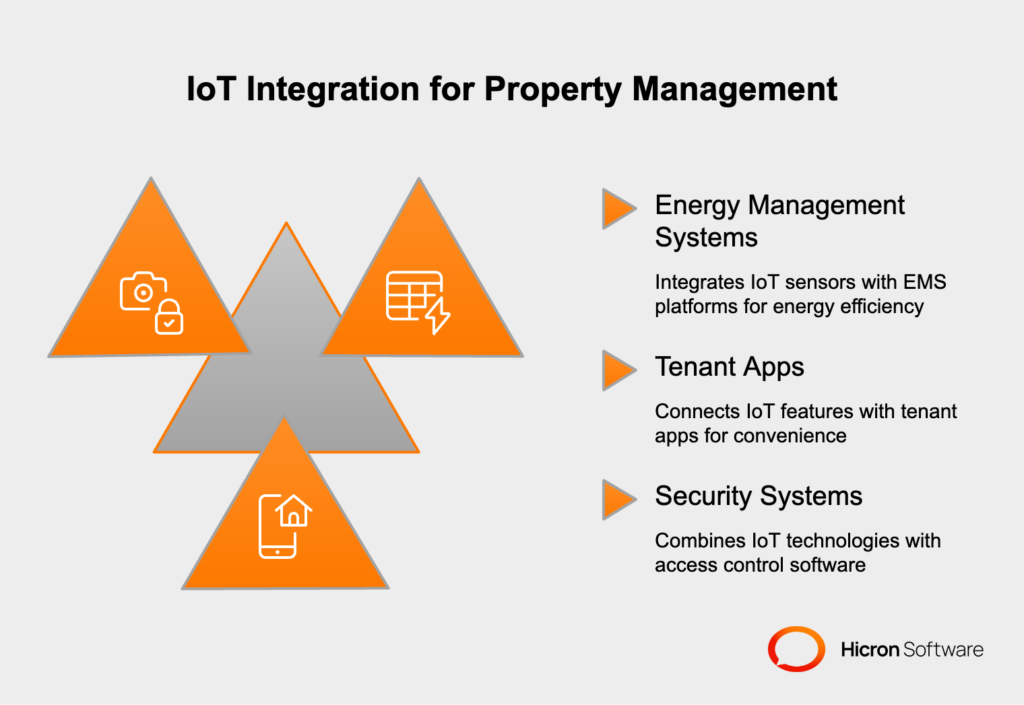
Not all properties have the same operational needs, which makes IoT flexibility essential for diverse portfolios. Whether it’s a high-rise commercial building, a single-family rental, or a university dormitory, IoT solutions should be capable of adapting to the specific requirements of each environment.
For multi-family residential properties, IoT systems can prioritize tenant comfort and convenience. Smart thermostats, remote lighting control, and AI-driven energy optimization tools are particularly valuable in this context. Integration with tenant-facing apps can make these features even more accessible.
Custom IoT systems in commercial buildings often focus on operational efficiency and security. For example, IoT-enabled occupancy sensors can adjust HVAC or lighting based on room usage, reducing energy costs. Smart access solutions, such as facial recognition or employee-specific access badges, can further enhance security while providing efficient entry management.
Properties like warehouses or industrial facilities might require IoT functionalities tailored to their operational complexities. For instance, temperature and humidity sensors can ensure optimal storage conditions for perishable goods, while real-time tracking systems monitor inventory movement.
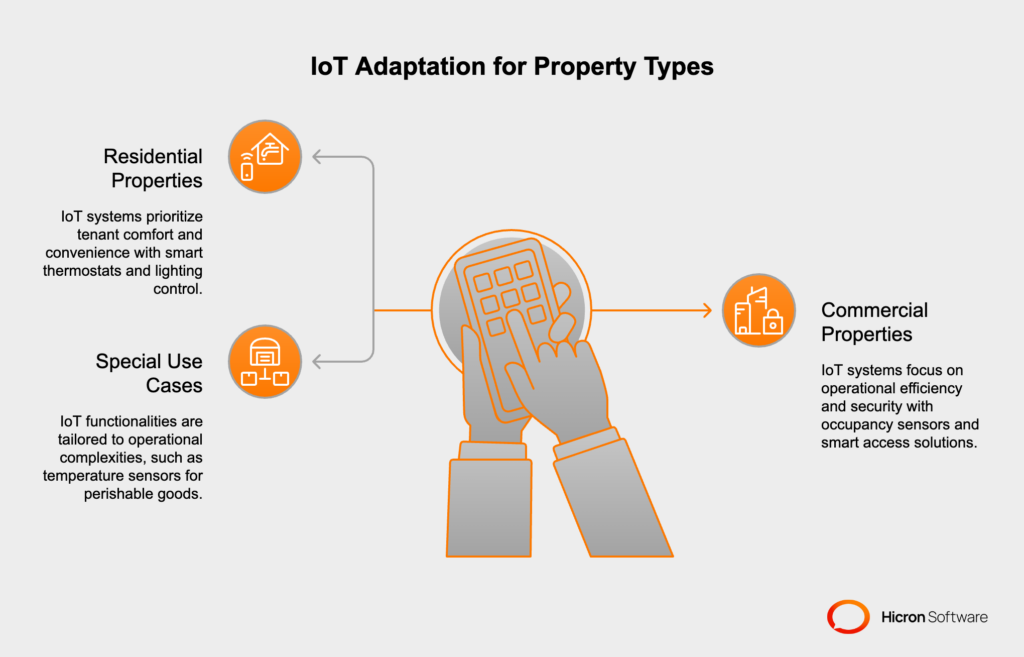
Effective customization often requires collaboration with IoT vendors and software solution providers who understand the unique challenges of the property management industry. When selecting a vendor, property managers should prioritize those who offer flexible configuration options and robust technical support.
Open-standards-compliant solutions are particularly valuable. These enable IoT platforms to interact with a wide range of devices and software, making it easier to introduce new features or integrate with emerging technologies. Vendors who encourage co-creation with the property management team, for example, through workshops or pilot programs, set the stage for fine-tuning IoT systems to business needs.
Flexible vendor policies help property managers avoid the pitfalls of vendor lock-in, ensuring that their IoT ecosystem can evolve with the portfolio without being tied to a single provider’s limitations.
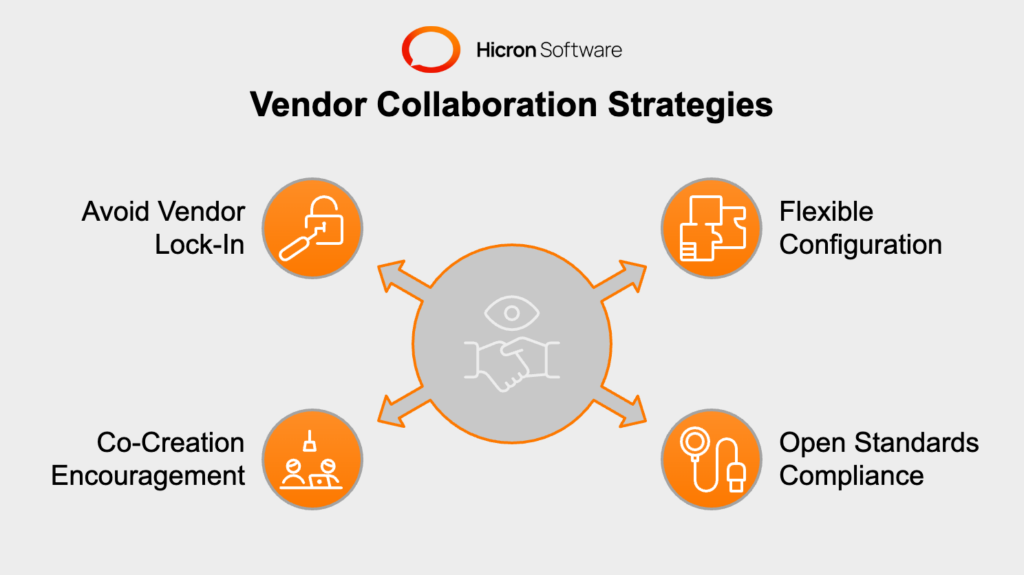
Customizing IoT systems delivers enormous value, both to property managers and tenants. For managers, it ensures that the technology fully supports operational goals, from improving efficiency to reducing costs. For tenants, tailored solutions enhance the user experience and highlight management’s commitment to innovation. The flexibility of customized IoT systems ensures that as a property portfolio evolves, the technology can adapt to meet new demands.
Implementing tailored IoT solutions requires thoughtful planning and collaboration, but the benefits far outweigh the effort. Property portfolios equipped with personalized IoT features are better positioned to compete in an increasingly tech-savvy market, delivering unparalleled experiences while maximizing operational effectiveness.
The integration of IoT into property portfolios has the power to transform the way buildings are managed and experienced. By leveraging IoT, property managers can streamline operational efficiency, enhance tenant satisfaction, and maximize the long-term value of their portfolios. From automating routine processes to providing real-time insights for decision-making, IoT technology enables property managers to stay ahead in an increasingly competitive industry.
For property portfolios of all sizes, IoT represents a strategic investment in the future. With the ability to adapt to evolving needs, reduce operational costs, and improve tenant experiences, IoT integration is an opportunity that no forward-thinking property manager can afford to overlook.
Are you ready to take your property portfolio to the next level? Our team of technology experts is here to help you create customized solutions tailored to your business needs. Contact us today to start building a smarter, more efficient, and thriving portfolio with the power of IoT.
IoT (Internet of Things) is a network of interconnected devices that collect and analyze data to enhance operational efficiency, automate tasks, and improve tenant satisfaction in property management.
IoT is used for smart building systems (HVAC, lighting, energy management), security and access control, predictive maintenance, space utilization, and sustainability initiatives.
IoT automates routine tasks, enables real-time monitoring, and provides predictive maintenance, reducing manual work, minimizing downtime, and cutting costs.
Key challenges include data security, high initial costs, scalability, maintenance, and gaining stakeholder buy-in.
Begin with a structured approach: assess current infrastructure, set clear goals, prioritize properties for rollout, and collaborate with vendors for tailored solutions.
